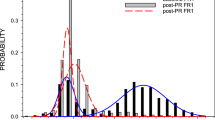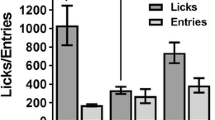Abstract
Rationale
A differential-reinforcement-of-low-rate schedule (DRL) delivers reinforcement only when the interresponse time (IRT) exceeds a fixed time interval, thereby shaping rats to discriminate the timing of their responses. However, little is known about the motor behavior and location of the rats in the chamber during the IRTs that lead to reinforcement. Although amphetamine is known to disrupt DRL timing behavior, the effects of this drug on non-operant motor behavior during DRL performance has not yet been quantified.
Objective
The purpose of this research was to measure the motor behavior (movement trajectories in the horizontal plane and spatial location in the plane) during longer IRTs after either vehicle or amphetamine treatment.
Materials and methods
Experimental chambers were constructed with a force-plate actometer as the floor, and while performing the operant task, the rats’ motor behaviors were measured continuously with high temporal and spatial resolution. Separate groups of eight male Sprague–Dawley rats were maintained on either DRL 24-s or DRL 72-s schedules of water reinforcement in 4-h recording sessions.
Results
Analyses of IRT distributions showed that the rats’ timing behavior conformed to their respective DRL requirements. In the absence of drug, analysis of motor behavior in pre-reinforcement intervals showed that rats located themselves away from the operandum and exhibited very low levels of movement. Rats exhibited a significant temporal diminution of horizontal movement that reached a minimum 4–8 s before the rats moved to the operandum to execute operant responses. Amphetamine treatment increased locomotion, abolished the temporal movement gradient, and brought the rats closer to the operandum compared to vehicle treatment. Movement changes induced by amphetamine were accompanied by degraded timing behavior.
Conclusions
Taken together, the data show that DRL training induced rats to locate themselves away from the operandum and to remain nearly motionless during longer IRTs and that amphetamine treatment interfered with this complex of behavioral features








Similar content being viewed by others
References
Balcells-Olivero M, Richards JB, Seiden LS (1997) Sensitization to amphetamine on the differential reinforcement of low rate 72-s schedule. Psychopharmacology 133:207–213
Balcells-Olivero M, Cousins MS, Seiden LS (1998) Holtzman and Harlan Sprague–Dawley rats: differences in DRL 72-sec performance and 8-hydroxy-di-propylamino tetralin-induced hypothermia. Jol Pharmacol Exp Ther 286:742–752
Bannerman DM, Yee BK, Good MA, Heupel MJ, Iversen SD, Rawlins JNP (1999) Double dissociation of function within the hippocampus: a comparison of dorsal, ventral, and complete hippocampal cytotoxic lesions. Behav Neurosci 113:1170–1188
Blackman DE (1989) Behavioral tolerance and sensitization. In: Goudie AJ, Emmett-Oglesby MW (eds) Psychtropic drugs: tolerance and sensitization. Humana, New Jersey, pp 521–545
Bull E, Reavill C, Hagan JJ, Overend P, Jones DN (2000) Evaluation of the spontaneously hypertensive rat as a model of attention deficit hyperactivity disorder: acquisition and performance of the DRL-60s test. Behav Brain Res 109:27–35
Costa VC, Bueno JL, Xavier GF (2005) Dentate gyrus-selective colchicine lesion and performance in temporal and spatial tasks. Behav Brain Res 160:286–303
Doughty AH, Richards JB (2002) Effects of reinforcer magnitude on responding under differential-reinforcement-of-low-rate schedules of rats and pigeons. J Exp Anal Behav 78:17–30
Featherstone RE, Rizos Z, Nobrega JN, Kapur S, Fletcher PJ (2007) Gestational methylazoxymethanol acetate treatment impairs select cognitive functions: parallels to schizophrenia. Neuropsychopharmacology 32:483–492
Fowler SC, Birkestrand BR, Chen R, Moss SJ, Vorontsova E, Wang G, Zarcone TJ (2001) A force-plate actometer for quantitating rodent behaviors: illustrative data on locomotion, rotation, spatial patterning, stereotypies, and tremor. J Neurosci Methods 107:107–124
Fowler SC, Birkestrand B, Vorontsova CR, Zarcone TJ (2003) Behavioral sensitization to amphetamine in rats: changes in the rhythm of head movements during focused stereotypies. Psychopharmacology 170:167–177
Fowler SC, Pinkston J, Vorontsova E (2007a) Clozapine and prazosin slow the rhythm of head movements during focused stereotypy induced by d-amphetamine in rats. Psychopharmacology 192:219–230
Fowler SC, Covington HE, Miczek K (2007b) Stereotyped and complex motor routines expressed during cocaine self-administration: results from a twenty-four hour binge of unlimited cocaine access in rats. Psychopharmacology 192:465–478
Killeen PR, Fetterman JG (1988) A behavioral theory of timing. Psychol Rev 95:274–295
Kuczenski R, Segal DS (1999) Sensitization of d-amphetamine-induced stereotypy during the acute response. J Pharmacol Exp Ther 288:699–709
Laties VG, Weiss B, Clark RL, Reynolds MD (1965) Overt mediating behavior during temporally spaced responding. J Exp Anal Behav 8:107–116
McGown WP, Spencer WB, Neetz R (1977) An investigation of collateral wood-chewing as a time-mediating device. Psychol Rep 41:1063–1069
McIntire K, Lundervold D, Calmes H, Jones C, Allard S (1983) Temporal control in a complex environment an analysis of schedule-related behavior. J Exp Anal Behav 39:465–478
McMillan DE (1969) Reinforcement contingencies maintaining collateral responding under DRL schedule. J Exp Anal Behav 12:413–422
Meck WH, Church RM, Olton DS (1984) Hippocampus, time, and memory. Behav Neurosci 98:3–22
Monterosso J, Ainslie G (1999) Beyond discounting: possible experimental models of impulse control. Psychopharmacology 146:339–347
O’Donnell JM, Seiden LS (1983) Differential-reinforcement-of-low-rate 72-second schedule: selective effects of antidepressant drugs. J Pharmacol Exp Ther 224:80–88
O’Donnell JM, Marek GJ, Seiden LS (2005) Antidepressant effects assessed using behavior maintained under a differential-reinforcement-of-low-rate (DRL) operant schedule. Neurosci Biobehav Rev 29:785–798
Osterhaus GL, Lester A, Fowler SC (2007) Microdialysis-measured brain levels of amphetamine in two rats strains expressing focused stereotypy. Program No. 745.13, Abstract Viewer/Itinerary Planner. Society for Neuroscience, San Diego, CA
Pearl RG, Seiden LS (1976) The existence of tolerance to and cross-tolerance between d-amphetamine and methylphenidate for their effects on milk consumption and on differential-reinforcement-of-low-rate performance in the rat. J Pharmacol Exp Ther 198:635–647
Richards JB, Sabol KE, Seiden LS (1993) DRL interresponse-time distributions: quantification by peak deviation analysis. J Exp Anal Behav 60:361–385
Richelle M, LeJeune H (1980) Time in animal behavior. Pergamon, New York
Sanabria F, Killeen PR (2008) Evidence for impulsivity in the spontaneously hypertensive rat drawn from complementary response-withholding tasks. Behav Brain Funct 4:7
Schuster CR, Zimmerman J (1962) Timing behavior during prolonged treatment with dl-amphetamine. J Exp Anal Behav 5:327–330
Staddon JER (1977) Schedule-induced behavior. In: Honig WK, Staddon JER (eds) Handbook of operant behavior. Prentice Hall, Engelwood Cliffs, NJ, pp 125–152
van den Bergh FS, Bloemarts E, Chan JS, Groenink L, Olivier B, Oosting RS (2006) Spontaneously hypertensive rats do not predict symptoms of attention-deficit hyperactivity disorder. Pharmacol Biochem Behav 83:380–390
Vezina P, Stewart J (1989) The effect of dopamine receptor blockade on the development of sensitization to the locomotor activating effects of amphetamine and morphine. Brain Res 499:108–120
Young B, McNaughton N (2000) Common firing patterns of hippocampal cells in a differential reinforcement of low rates of response schedule. J Neurosci 20:7043–7051
Zuriff GE (1969) Collateral responding during differential reinforcement of low rates. J Exp Anal Behav 12:971–976
Acknowledgments
This work was supported by MH43429 and HD02528.
Author information
Authors and Affiliations
Corresponding author
Rights and permissions
About this article
Cite this article
Fowler, S.C., Pinkston, J. & Vorontsova, E. Timing and space usage are disrupted by amphetamine in rats maintained on DRL 24-s and DRL 72-s schedules of reinforcement. Psychopharmacology 204, 213–225 (2009). https://doi.org/10.1007/s00213-008-1451-x
Received:
Accepted:
Published:
Issue Date:
DOI: https://doi.org/10.1007/s00213-008-1451-x




